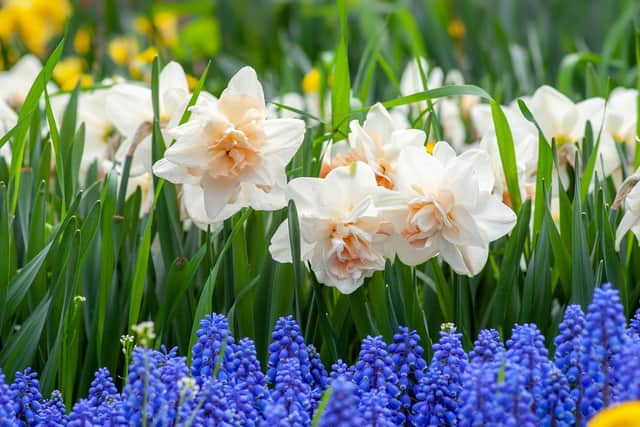Spring Into Action: A comprehensive guide to prepping your garden for the season
and live on Freeview channel 276
So grab your gloves, dig in the dirt, and let the gardening adventures begin!
As the winter frost begins to thaw and the days grow longer, garden enthusiasts eagerly anticipate the arrival of spring! It's the perfect time to roll up your sleeves, dust off your gardening tools, and prepare your outdoor oasis for a flourishing season ahead.
Advertisement
Hide AdAdvertisement
Hide AdWhether you're a seasoned gardener or a novice with a green thumb, this step-by-step guide will help you get your garden in tip-top shape for spring.


Step 1: Assess Your Garden
Before diving into the physical work take some time to assess your garden. Walk around and observe the condition of your plants, soul, and structures. Note any areas that need attention such as damaged fences, overgrown shrubs, or depleted soil. This initial assessment will guide your planning and help prioritize tasks.
Step 2: Clean up and Clear Out
Start by clearing away debris and dead foliage from the winter months. Remove fallen leaves, branches, and any other organic matter that may have accumulated. If you have a compost, this stuff would be a great addition! Trim back overgrown plants and prune dead or damaged branches to encourage healthy new growth. Clearing out the clutter will not only improve the aesthetic but also create space for new growth.
Step 3: Soil Preparation
Healthy soil is the foundation of a thriving garden. Begin by testing PH levels to test it's acidity or alkalinity. These tests are easy to find online or at your local hardware store. Most plants prefer a slightly acidic to neutral pH level. Amend the soil as needed by adding organic matter such as compost, manure, or mulch to improve its texture and nutrient content. Till and turn the soil thoroughly to incorporate the amendments and ensure even distribution.
Step 4: Plan Your Plantings
Advertisement
Hide AdTake this opportunity to plan out your garden layout and decide which plants you want to grow. Consider factors such as sunlight exposure, water requirements, and the mature size of each plant. Choose a variety of flowers, vegetables, and herbs to create a unique visual aesthetic and promote biodiversity. Make sure you group plants with similar needs together for easier maintenance.
Step 5: Start Seeds Indoors
Advertisement
Hide AdFor plants that require a longer growing season, such as tomatoes and peppers, or to simply get an earlier start on your garden, consider starting your seeds indoors. It's quite simple. You can use seed trays, small pots, or simply an old egg carton. Simply put your seeds in with some potting soil, a dash of water, and stick them in a warm, sunny location, such as a windowsill. Keep the soil moist and provide adequate ventilation to prevent mould or mildew. Transplant seedlings into the garden once they have developed strong roots and the threat of frost has passed.
Step 6: Tend Your Tools
Before getting down to planting, take time to clean and sharpen your tools. Remove any rust or debris from shovels spades and pruners. Oil the metal parts to prevent corrosion. Sharpening blades will ensure clean cuts and optimal performance. Properly maintained tools will make your gardening tasks easier and more efficient.
Step 7: Pesky Pests
As temperatures rise, so does the population of garden pests. Take proactive steps to protect your garden from common pests such as aphids, snails, ants, and caterpillars. Please consider using only natural deterrents! There are many natural ways to deter pests and if implemented, chemicals will not be necessary. Harsh chemicals are not only dangerous to your plants, but to your family as well, especially pets! Certain plants actually attract these critters so do your research before planting. Consider plants that attract beneficial insects like ladybugs or praying mantis. Try companion planting or insecticidal soap. Stay on top of things by regularly checking your plants for signs of pest infestations.
Step 8: Mulch and Water
Advertisement
Hide AdApply a layer of mulch to your garden beds to help retain moisture, suppress weeds, and regulate soil temperature. Organic mulches such as straw, wood chips, or shredded leaves are ideal for improving soil health and promoting plant growth. Water your garden consistently especially during dry spells or periods of intense heat. Aim to water in the early mornings or late afternoons to minimize evaporation and ensure maximum absorption by the plants.
Step 9: Monitor & Maintain
Once your garden is prepped and planted, don't forget to monitor its progress and provide ongoing care. Keep an eye out for signs of nutrient deficiency, disease, or post damage and address any issues promptly. Stay on top of weeding, watering and fertilizing to keep your garden looking its best throughout the spring and beyond.
Step 10: Enjoy the Fruits of your Labour
Advertisement
Hide AdFinally, take the time to sit back, relax, and enjoy the beauty of your flourishing garden. Whether you're savouring the sights and sense of blooming flowers, harvesting fresh vegetables for a delicious meal, or simply basking in the tranquillity of nature, your efforts will be rewarded tenfold. Embrace the joys of gardening and revel in the vibrant colours and life that spring brings to your outdoor sanctuary.
With these 10 steps as your guide, you will be well equipped to prepare your garden for spring and set the stage for a season of growth, abundance, and natural beauty. So grab your gloves, dig in the dirt and let the gardening adventurers begin!